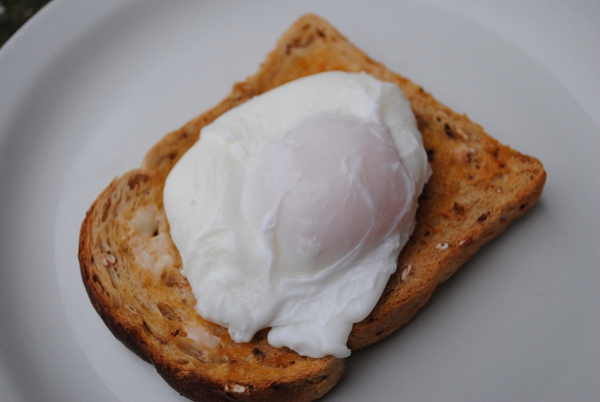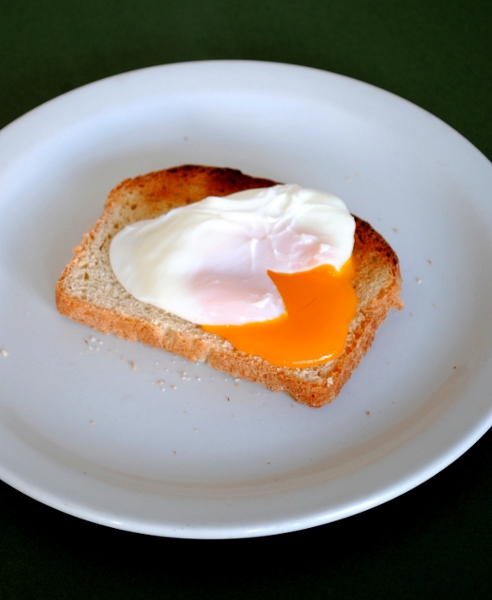Poaching ideas
‘Man shall not live by bread alone’ 1, which is why I like to go off-topic from time to time, and today I would like to offer you a paean to one of my favourite dishes: poached eggs. Unfortunately, poaching eggs is a tricky business. Of course, you can use any one of various implements designed to simplify it, but a true poached egg has to be cooked directly in water, and nothing else really hits the mark. The learned culinary tradition is to whisk a pan of boiling water into a whirlpool and crack the egg into its centre. The theory is that the centripetal force of the water prevents the egg white from exploding into weblike strands, as it would otherwise tend to do on contact with water. Doubtless this technique can be made to work, but I’ve never succeeded with it myself, and not for lack of trying.
Just recently I came across a method popularised by Julia Child, the doyenne of American cookery writers. Child advocated pricking the base of the egg with a pin, boiling it for 10 seconds, then reducing the heat so that the water is barely simmering and cracking the parboiled egg into the pan. Although brief, exposure to the heat of the boiling water should be enough to set the very outer layer of the egg and prevent it from exploding when dropped into water. Piercing the egg is a precaution. The base of the egg contains an air cell, which will expand as it heats and can split the shell. If this happens, when the time comes to crack the egg it may come apart in your hands.
 Child also advised adding a little vinegar to the water, which is a time-honoured method of enouraging the white to set. Egg white is almost pure protein (muscle-building drinks are often based on egg protein), which sets or denatures when heated. The same thing happens to the gluten in bread during baking. It so happens that acidity also denatures protein. For example, the South American dish ceviche uses a marinade of citrus acids to ‘cook’ fish. By adding vinegar (which is essentially dilute acetic acid) to boiling water we effectively speed up the process by which the egg white sets firm. Having said all that, I don’t bother using vinegar any more: although scientifically sound in principle, I just don’t find it makes that much difference.
Child also advised adding a little vinegar to the water, which is a time-honoured method of enouraging the white to set. Egg white is almost pure protein (muscle-building drinks are often based on egg protein), which sets or denatures when heated. The same thing happens to the gluten in bread during baking. It so happens that acidity also denatures protein. For example, the South American dish ceviche uses a marinade of citrus acids to ‘cook’ fish. By adding vinegar (which is essentially dilute acetic acid) to boiling water we effectively speed up the process by which the egg white sets firm. Having said all that, I don’t bother using vinegar any more: although scientifically sound in principle, I just don’t find it makes that much difference.
Well, the Child method isn’t foolproof, and the best results come with luck or practice, but it’s the best technique I’ve yet tried. I’ve actually had better and more consistent results by boiling for 20 seconds rather than 10, and the part that needs mastering is cracking the egg. You need to do this cleanly and with as little force as you can manage, so that the egg – which is still very delicate – is disturbed as little as possible. If you find yourself having to prise the shell open with your thumbs after cracking it, it may not work, and you risk bursting the yolk. For a runny yolk I simmer them over the lowest possible heat for about 3 minutes (on an electric hotplate it helps to use a diffuser because it takes so long for the plate to cool down). A minute or so longer should suffice if you are one of those peculiar sorts who like their yolks firm. Now rescue your eggs with a slotted spoon or skimmer: with any luck, you will be rewarded with the sort of results that a professional would be proud of.
For a runny yolk I simmer them over the lowest possible heat for about 3 minutes (on an electric hotplate it helps to use a diffuser because it takes so long for the plate to cool down). A minute or so longer should suffice if you are one of those peculiar sorts who like their yolks firm. Now rescue your eggs with a slotted spoon or skimmer: with any luck, you will be rewarded with the sort of results that a professional would be proud of.
Notes:
- That’s Matthew 4:4 if you were wondering. ↩
